SEP A stable election protocol for clustered heterogeneous wireless sensor networks
- 格式:pdf
- 大小:265.79 KB
- 文档页数:11
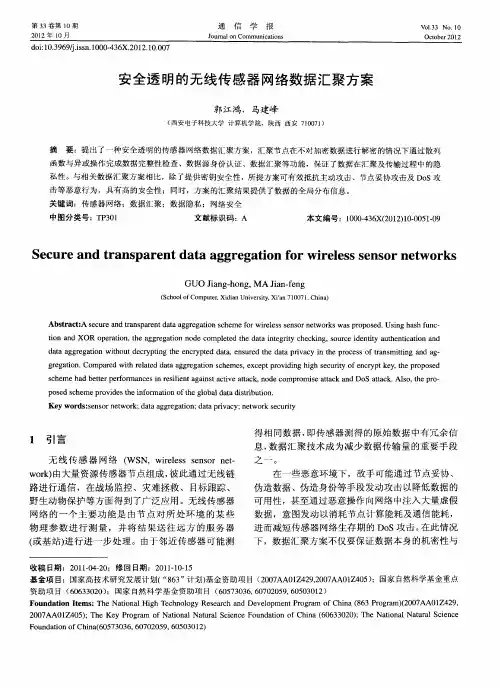
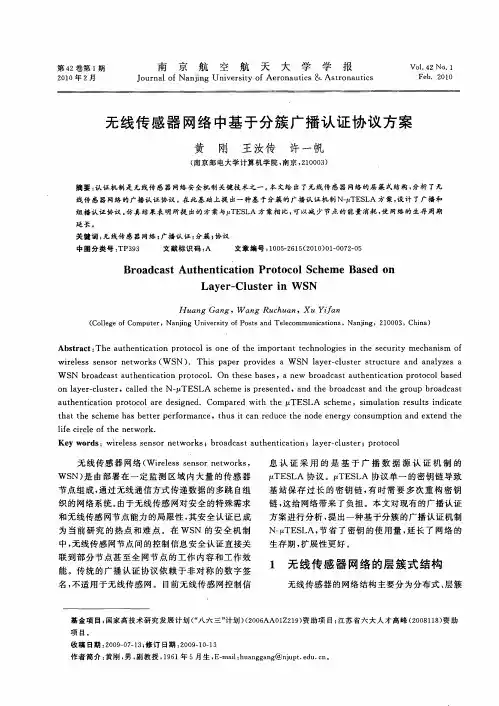
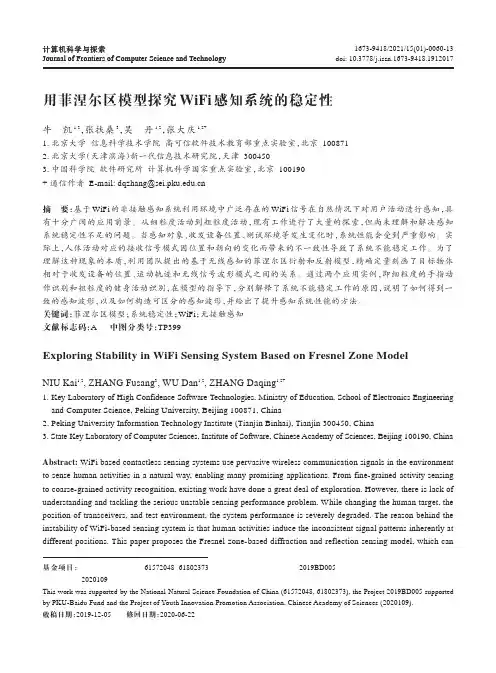
用菲涅尔区模型探究WiFi 感知系统的稳定性牛凯1,2,张扶桑3,吴丹1,2,张大庆1,2+1.北京大学信息科学技术学院高可信软件技术教育部重点实验室,北京1008712.北京大学(天津滨海)新一代信息技术研究院,天津3004503.中国科学院软件研究所计算机科学国家重点实验室,北京100190+通信作者E-mail:*************** 摘要:基于WiFi 的非接触感知系统利用环境中广泛存在的WiFi 信号在自然情况下对用户活动进行感知,具有十分广阔的应用前景。
从细粒度活动到粗粒度活动,现有工作进行了大量的探索,但尚未理解和解决感知系统稳定性不足的问题。
当感知对象、收发设备位置、测试环境等发生变化时,系统性能会受到严重影响。
实际上,人体活动对应的接收信号模式因位置和朝向的变化而带来的不一致性导致了系统不能稳定工作。
为了理解这种现象的本质,利用团队提出的基于无线感知的菲涅尔区衍射和反射模型,精确定量刻画了目标物体相对于收发设备的位置、运动轨迹和无线信号波形模式之间的关系。
通过两个应用实例,即细粒度的手指动作识别和粗粒度的健身活动识别,在模型的指导下,分别解释了系统不能稳定工作的原因,说明了如何得到一致的感知波形,以及如何构造可区分的感知波形,并给出了提升感知系统性能的方法。
关键词:菲涅尔区模型;系统稳定性;WiFi ;无接触感知文献标志码:A中图分类号:TP399Exploring Stability in WiFi Sensing System Based on Fresnel Zone ModelNIU Kai 1,2,ZHANG Fusang 3,WU Dan 1,2,ZHANG Daqing 1,2+1.Key Laboratory of High Confidence Software Technologies,Ministry of Education,School of Electronics Engineering and Computer Science,Peking University,Beijing 100871,China2.Peking University Information Technology Institute (Tianjin Binhai),Tianjin 300450,China3.State Key Laboratory of Computer Sciences,Institute of Software,Chinese Academy of Sciences,Beijing 100190,China Abstract:WiFi based contactless sensing systems use pervasive wireless communication signals in the environment to sense human activities in a natural way,enabling many promising applications.From fine-grained activity sensing to coarse-grained activity recognition,existing work have done a great deal of exploration.However,there is lack of understanding and tackling the serious unstable sensing performance problem.While changing the human target,the position of transceivers,and test environment,the system performance is severely degraded.The reason behind the instability of WiFi-based sensing system is that human activities induce the inconsistent signal patterns inherently at different positions.This paper proposes the Fresnel zone-based diffraction and reflection sensing model,which can计算机科学与探索1673-9418/2021/15(01)-0060-13doi:10.3778/j.issn.1673-9418.1912017基金项目:国家自然科学基金(61572048,61802373);北大百度基金资助项目(2019BD005);中国科学院青年创新促进会项目(2020109)。
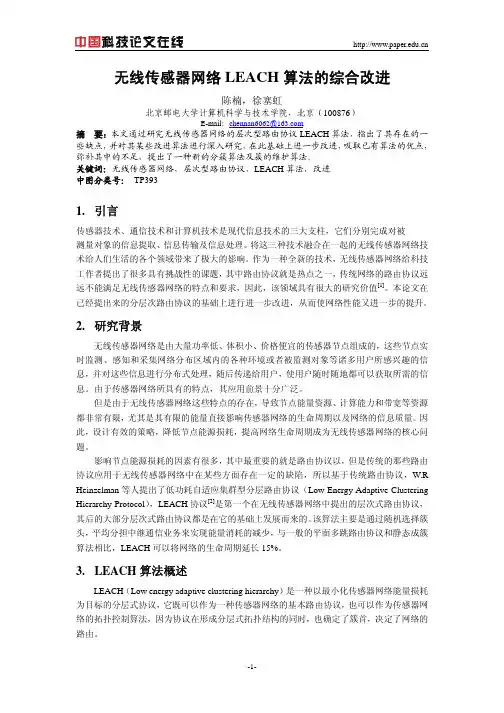
无线传感器网络LEACH算法的综合改进陈楠,徐塞虹北京邮电大学计算机科学与技术学院,北京(100876)E-mail:chennan6062@摘要:本文通过研究无线传感器网络的层次型路由协议LEACH算法,指出了其存在的一些缺点,并对其某些改进算法进行深入研究,在此基础上进一步改进,吸取已有算法的优点,弥补其中的不足,提出了一种新的分簇算法及簇的维护算法。
关键词:无线传感器网络,层次型路由协议,LEACH算法,改进中图分类号:TP3931.引言传感器技术、通信技术和计算机技术是现代信息技术的三大支柱,它们分别完成对被测量对象的信息提取、信息传输及信息处理。
将这三种技术融合在一起的无线传感器网络技术给人们生活的各个领域带来了极大的影响。
作为一种全新的技术,无线传感器网络给科技工作者提出了很多具有挑战性的课题,其中路由协议就是热点之一,传统网络的路由协议远远不能满足无线传感器网络的特点和要求,因此,该领域具有很大的研究价值[1]。
本论文在已经提出来的分层次路由协议的基础上进行进一步改进,从而使网络性能又进一步的提升。
2.研究背景无线传感器网络是由大量功率低、体积小、价格便宜的传感器节点组成的,这些节点实时监测、感知和采集网络分布区域内的各种环境或者被监测对象等诸多用户所感兴趣的信息,并对这些信息进行分布式处理,随后传递给用户,使用户随时随地都可以获取所需的信息。
由于传感器网络所具有的特点,其应用前景十分广泛。
但是由于无线传感器网络这些特点的存在,导致节点能量资源、计算能力和带宽等资源都非常有限,尤其是其有限的能量直接影响传感器网络的生命周期以及网络的信息质量。
因此,设计有效的策略,降低节点能源损耗,提高网络生命周期成为无线传感器网络的核心问题。
影响节点能源损耗的因素有很多,其中最重要的就是路由协议以,但是传统的那些路由协议应用于无线传感器网络中在某些方面存在一定的缺陷,所以基于传统路由协议,W.R Heinzelman等人提出了低功耗自适应集群型分层路由协议(Low Energy Adaptive Clustering Hierarchy Protocol),LEACH协议[2]是第一个在无线传感器网络中提出的层次式路由协议,其后的大部分层次式路由协议都是在它的基础上发展而来的。

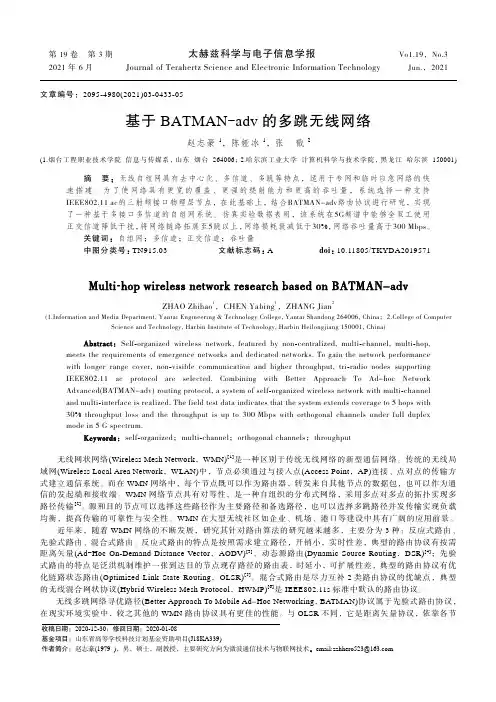
第19卷 第3期太赫兹科学与电子信息学报Vo1.19,No.3 2021年6月 Journal of Terahertz Science and Electronic Information Technology Jun.,2021文章编号:2095-4980(2021)03-0433-05基于BATMAN-adv的多跳无线网络赵志豪1,陈娅冰1,张戬 2(1.烟台工程职业技术学院信息与传媒系,山东烟台 264006;2.哈尔滨工业大学计算机科学与技术学院,黑龙江哈尔滨 150001)摘 要:无线自组网具有去中心化、多信道、多跳等特点,适用于专网和临时应急网络的快速搭建。
为了使网络具有更宽的覆盖、更强的绕射能力和更高的吞吐量,系统选择一种支持IEEE802.11 ac的三射频接口物理层节点,在此基础上,结合BATMAN-adv路由协议进行研究,实现了一种基于多接口多信道的自组网系统。
仿真实验数据表明,该系统在5G频谱中能够全双工使用正交信道降低干扰,将网络链路拓展至5跳以上,网络损耗衰减低于30%,网络吞吐量高于300Mbps。
关键词:自组网;多信道;正交信道;吞吐量中图分类号:TN915.03 文献标志码:A doi:10.11805/TKYDA2019571Multi-hop wireless network research based on BATMAN-advZHAO Zhihao1,CHEN Yabing1,ZHANG Jian2(rmation and Media Department, Yantai Engineering & Technology College, Yantai Shandong 264006, China;2.College of ComputerScience and Technology, Harbin Institute of Technology, Harbin Heilongjiang 150001, China)Abstract:Self-organized wireless network, featured by non-centralized, multi-channel, multi-hop, meets the requirements of emergence networks and dedicated networks. To gain the network performancewith longer range cover, non-visible communication and higher throughput, tri-radio nodes supportingIEEE802.11 ac protocol are selected. Combining with Better Approach To Ad-hoc NetworkAdvanced(BATMAN-adv) routing protocol, a system of self-organized wireless network with multi-channeland multi-interface is realized. The field test data indicates that the system extends coverage to 5 hops with30%throughput loss and the throughput is up to 300Mbps with orthogonal channels under full duplexmode in 5G spectrum.Keywords:self-organized;multi-channel;orthogonal channels;throughput无线网状网络(Wireless Mesh Network,WMN)[1]是一种区别于传统无线网络的新型通信网络。
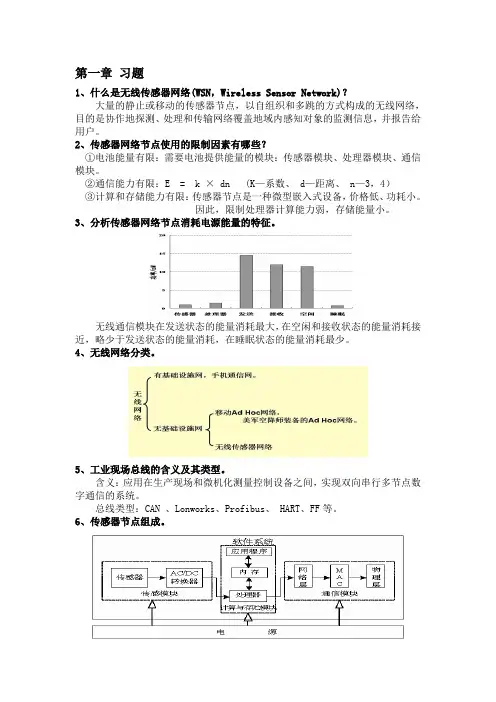
第一章习题1、什么是无线传感器网络(WSN,Wireless Sensor Network)?大量的静止或移动的传感器节点,以自组织和多跳的方式构成的无线网络,目的是协作地探测、处理和传输网络覆盖地域内感知对象的监测信息,并报告给用户。
2、传感器网络节点使用的限制因素有哪些?①电池能量有限:需要电池提供能量的模块:传感器模块、处理器模块、通信模块。
②通信能力有限:E = k × dn (K—系数、 d—距离、 n—3,4)③计算和存储能力有限:传感器节点是一种微型嵌入式设备,价格低、功耗小。
因此,限制处理器计算能力弱,存储能量小。
3、分析传感器网络节点消耗电源能量的特征。
无线通信模块在发送状态的能量消耗最大,在空闲和接收状态的能量消耗接近,略少于发送状态的能量消耗,在睡眠状态的能量消耗最少。
4、无线网络分类。
5、工业现场总线的含义及其类型。
含义:应用在生产现场和微机化测量控制设备之间,实现双向串行多节点数字通信的系统。
总线类型:CAN 、Lonworks、Profibus、 HART、FF等。
6、传感器节点组成。
传感器模块:信息采集、数据转换处理器模块:控制、数据处理无线通讯模块:无线通信,交换控制信息和收发采集数据电源模块:提供能量第二章习题1、无线传感器网络的拓扑结构有哪几种?按照节点功能及结构层次,无线传感器网络拓扑结构分为:①平面网络结构②分层网络结构③混合网络结构④Mesh网络结构2、Mesh结构的无线传感器网络的特点是什么?有哪些具体应用?特点:节点分布规则;节点功能相同;节点之间都存在多跳路径。
应用:人员和车辆安全监控系统。
第三章习题1、目前无线传感器网络的通信传输介质有哪些类型?无线通信介质:无线电波、微波、红外线等。
2、无线网络通信系统为什么要进行调制和解调?调制有哪些方法?原因:由于基带信号频率低,信号发射天线尺寸会很大;方法:频分复用。
模拟调制: AM、 FM、 PM。
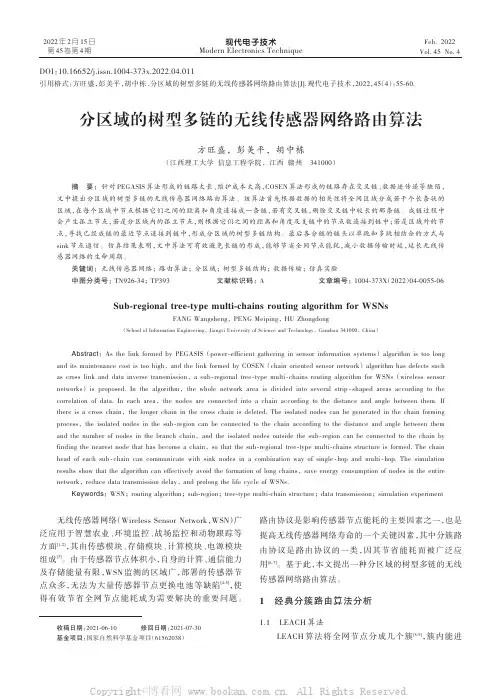
现代电子技术ModernElectronicsTechnique
Feb.2022
Vol.45No.42022年2月15日
第45卷第4期
无线传感器网络(WirelessSensorNetwork,WSN)广泛应用于智慧农业、环境监控、战场监控和动物跟踪等方面[1⁃2],其由传感模块、存储模块、计算模块、电源模块组成[3]。由于传感器节点体积小,自身的计算、通信能力及存储能量有限,WSN监测的区域广,部署的传感器节点众多,无法为大量传感器节点更换电池等缺陷[4⁃5],使得有效节省全网节点能耗成为需要解决的重要问题。路由协议是影响传感器节点能耗的主要因素之一,也是提高无线传感器网络寿命的一个关键因素,其中分簇路由协议是路由协议的一类,因其节省能耗而被广泛应用[6⁃7]。基于此,本文提出一种分区域的树型多链的无线传感器网络路由算法。
1经典分簇路由算法分析1.1LEACH算法LEACH算法将全网节点分成几个簇[8⁃9],簇内能进
DOI:10.16652/j.issn.1004⁃373x.2022.04.011引用格式:方旺盛,彭美平,胡中栋.分区域的树型多链的无线传感器网络路由算法[J].现代电子技术,2022,45(4):55⁃60.
分区域的树型多链的无线传感器网络路由算法方旺盛,彭美平,胡中栋(江西理工大学信息工程学院,江西赣州341000)
摘要:针对PEGASIS算法形成的链路太长、维护成本太高,COSEN算法形成的链路存在交叉链、数据逆传递等缺陷,文中提出分区域的树型多链的无线传感器网络路由算法。该算法首先根据数据的相关性将全网区域分成若干个长条状的区域,在每个区域中节点根据它们之间的距离和角度连接成一条链,若有交叉链,删除交叉链中较长的那条链。成链过程中会产生孤立节点,若是分区域内的孤立节点,则根据它们之间的距离和角度及支链中的节点数连接到链中;若是区域外的节点,寻找已经成链的最近节点连接到链中,形成分区域的树型多链结构。最后各分链的链头以单跳和多跳相结合的方式与sink节点通信。仿真结果表明,文中算法可有效避免长链的形成,能够节省全网节点能耗,减小数据传输时延,延长无线传
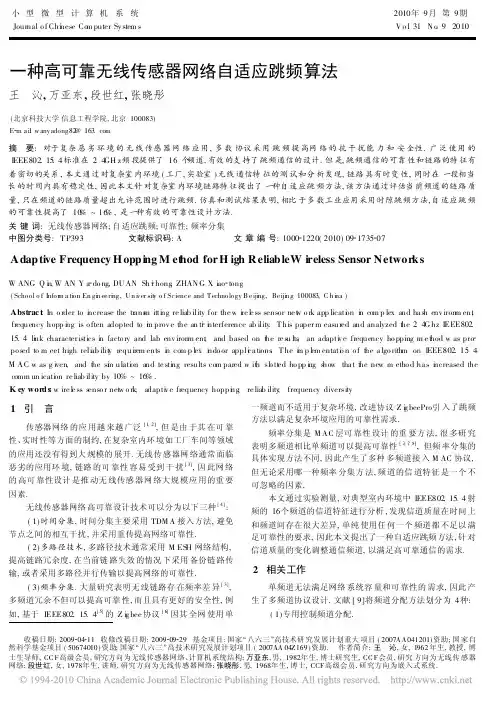
小型微型计算机系统Journal o f Chi nese Co m puter Sy stem s2010年9月第9期V o l 31N o .92010收稿日期:2009 04 11 收修改稿日期:2009 09 29 基金项目:国家 八六三 高技术研究发展计划重大项目(2007AA041201)资助;国家自然科学基金项目(50674010)资助;国家 八六三 高技术研究发展计划项目(2007AA 04Z169)资助. 作者简介:王 沁,女,1962年生,教授,博士生导师,CC F 高级会员,研究方向为无线传感器网络、计算机系统结构;万亚东,男,1982年生,博士研究生,CC F 会员,研究方向为无线传感器网络;段世红,女,1978年生,讲师,研究方向为无线传感器网络;张晓彤,男,1968年生,博士,CCF 高级会员,研究方向为嵌入式系统.一种高可靠无线传感器网络自适应跳频算法王 沁,万亚东,段世红,张晓彤(北京科技大学信息工程学院,北京100083)E m ai:l w anyadong82@摘 要:对于复杂恶劣环境的无线传感器网络应用,多数协议采用跳频提高网络的抗干扰能力和安全性.广泛使用的IEEE802.15.4标准在2.4GH z 频段提供了16个频道,有效的支持了跳频通信的设计.但是,跳频通信的可靠性和链路的特征有着密切的关系,本文通过对复杂室内环境(工厂,实验室)无线通信特征的测试和分析发现,链路具有时变性,同时在一段相当长的时间内具有稳定性,因此本文针对复杂室内环境链路特征提出了一种自适应跳频方法,该方法通过评估当前频道的链路质量,只在频道的链路质量超出允许范围时进行跳频.仿真和测试结果表明,相比于多数工业应用采用时隙跳频方法,自适应跳频的可靠性提高了10%~16%,是一种有效的可靠性设计方法.关键词:无线传感器网络;自适应跳频;可靠性;频率分集中图分类号:T P393 文献标识码:A 文章编号:1000 1220(2010)09 1735 07Adaptive Frequency H opping M et hod for H igh ReliableW ireless Sensor NetworksW ANG Q i n ,W AN Y a do ng,DU AN Sh i hong ,ZHAN G X i ao tong(School o f Infor m a ti on En gi n eeri ng,Un i ver sit y o f Science and Technology B eiji ng,Beiji n g 100083,C h i na )Abstrac t :In o rder to i ncrease the trans m itti ng re liab ility for the w i re l e ss sensor ne t w o rk app licati on i n com p lex and ha s h env iron m en,t frequency hopp i ng is o ften adopted to i m prov e the an ti i nterference ab ility .T his paper m easured and analyzed t he 2.4G hz IEEE802.15.4li nk character istics i n facto ry and lab env iron m en,t and based on t he re s u lts ,an adapti v e frequency ho pping m e t hod w as pro po s ed to m eet high reli ab ilit y requirem ents i n com p l ex i ndo or appli ca tions .T he i m p l em entati o n o f t he a lgo rith m on IEEE802.15.4M A C w as g i ven ,and t he si m ulati on and te sti ng results com pared w it h sl o tt ed ho pp i ng s how tha t t he new m etho d ha s i ncreased the comm un icati on re liab ility by 10%~16%.K ey word s :w ire l e ss s enso r net w o rk ;adapti v e frequency hoppi ng ;re liab ility ;frequency diversity1 引 言传感器网络的应用越来越广泛[1,2],但是由于其在可靠性、实时性等方面的制约,在复杂室内环境如工厂车间等领域的应用还没有得到大规模的展开.无线传感器网络通常面临恶劣的应用环境,链路的可靠性容易受到干扰[3],因此网络的高可靠性设计是推动无线传感器网络大规模应用的重要因素.无线传感器网络高可靠设计技术可以分为以下三种[4]:(1)时间分集,时间分集主要采用TDM A 接入方法,避免节点之间的相互干扰,并采用重传提高网络可靠性.(2)多路径技术,多路径技术通常采用M ES H 网络结构,提高链路冗余度,在当前链路失效的情况下采用备份链路传输,或者采用多路径并行传输以提高网络的可靠性.(3)频率分集.大量研究表明无线链路存在频率差异[3],多频道冗余不但可以提高可靠性,而且具有更好的安全性,例如,基于IEEE802.15.4[5]的Z i g bee 协议[6]因其全网使用单一频道而不适用于复杂环境,改进协议Z i g beePro 引入了跳频方法以满足复杂环境应用的可靠性需求.频率分集是M A C 层可靠性设计的重要方法,很多研究表明多频道相比单频道可以提高可靠性[3,7,8],但频率分集的具体实现方法不同,因此产生了多种多频道接入M AC 协议,但无论采用哪一种频率分集方法,频道的信道特征是一个不可忽略的因素.本文通过实验测量,对典型室内环境中IEEE802.15.4射频的16个频道的信道特征进行分析,发现信道质量在时间上和频道间存在很大差异,单纯使用任何一个频道都不足以满足可靠性的要求,因此本文提出了一种自适应跳频方法,针对信道质量的变化调整通信频道,以满足高可靠通信的需求.2 相关工作单频道无法满足网络系统容量和可靠性的需求,因此产生了多频道协议设计.文献[9]将频道分配方法划分为4种:(1)专用控制频道分配.(2)固定频道分配.(3)两阶段频道分配.(4)并行跳频频道分配.专用控制频道分配需要节点具备两个射频模块,其中一个专门用于跳频频道的协商,采用该种方法的典型协议为D CA [10].固定频道分配方式为每条链路分配一个频道,并一直使用该频道进行数据传输直到传输完成,采用该方法的多频道接入协议包括基于C S M A 的M M SN [11]、TM C P [12]以及基于TDM A 的M C LM A C [13]、T F M AC [14]等.分阶段的跳频将频道接入划分为两部分:频道控制部分和数据传输部分,数据传输阶段采用频道控制时段协商的频道进行通信,分阶段多频道接入协议包括M M A C [15]、TM M A C [16]等.并行跳频充分利用频道资源,为每次数据通信分配一个频道,所有的节点都处于跳频状态,并根据跳频序列确定下一次数据通信的频道.典型的协议包括M c M ac [17]以及D ust N et w o rk 提出的T SCH [18].T SCH 已被工业无线传感器网络标准草案w ire less HA RT [19]采用,在M AC 层采用时隙跳频提高可靠性,并用TDM A 避免冲突、提高数据传输延迟的确定性.ISA SP100.11a [20]采用慢跳频(S l ow hopp i ng )和时隙跳频(S l o tted hoppi ng )相结合的方法,时隙跳频在每个TDM A 时隙(通常为10m s)上进行跳频,通过跳频序列和频道偏移量来确定每条链路的下一个频道.慢跳频将一组时隙作为跳频时间段,长度通常为250m s .时隙跳频和慢跳频认为信道质量的变化是完全随机的,信道变化剧烈且不可预知,因此采用均匀访问频道的方法进行跳频.时隙跳频和慢跳频在跳频序列的设计上主要针对802.11同频段干扰做了优化,但其对硬件和时钟同步的要求比较高,而且在信道比较可靠的情况下跳频增加了系统复杂性.自适应跳频方面,大多研究基于无线个域网(W PAN s)设计自适应跳频算法,U.M e i e r [21]在复杂工厂环境中对基于蓝牙的无线传感器网络进行了测试,并指出由于蓝牙采用自适应跳频、纠错等技术,在距离小于30m 的情况下可以达到非常高的可靠性.文献[22]提出了一种E A FH 跳频方法提高无线个域网的抗干扰能力,EA FH 利用包错误率判断信道状态并对信道进行取舍.文献[23]提出了一种动态自适应跳频方法DA FD 以避免W PAN s 之间的相互干扰.文献[24]对基于多信道M A C 协议在无线传感器网络中的应用进行了总结.文献[25]提出了一种多频道节能M A C 协议,文献[26]提出了一种采用功率控制的多频道协议DCA PC ,两者都通过分布式协商分配频道;文献[27]为DM A C 协议增加了多频道接入功能,文献[28]介绍了一种基于簇的多频道M A C 协议,每个节点配置有3个收发模块,由簇头和簇成员共同完成频道分配.通过对工业现场链路特征的测试和分析,我们发现信道不仅会受到同频设备的干扰,而且自身也随环境发生变化,但信道的变化不是完全随机的,在相对较长的时间内(远大于250m s)具有一定的稳定性.因此我们利用信道特征进行跳频设计,以尽可能的提高网络可靠性.3 链路特征典型的复杂室内环境为工厂,信道质量容易受到外界环境的干扰,大量研究工作[29 31]表明,链路的可靠性存在灰色区域,灰色区域以外,链路具有良好的稳定性.我们用丢包率表示链路可靠性,在工厂环境和易受人员干扰的实验室环境对I EEE802.15.4链路进行了测试,测试结果如图1所示,横轴为时间,纵轴为不同频道上的PDR.图1 复杂室内环境下不同频道的链路质量F i g.1 L i nk reli ability i n com plex i ndoo r env i ron m en ts从测试结果可见:(1)链路的丢包率在不同的频道上具有很大的差异,即信道质量存在频道差异,比如图1(a )中的频道ch 1(即IEEE802.15.4频道11)链路丢包率小于5%,而频道ch 12的链路丢包率则大于90%.(2)信道质量具有时变特征.从图1可以看到,丢包率随时间发生变化,在丢包率较高和较低的频道,丢包率随时间的变化比较小,而在丢包率处于中间范围的频道随时间的变化比较大.(3)信道质量存在突然变化的情况,比如图1(b)的频道1736 小 型 微 型 计 算 机 系 统 2010年ch 13、ch 14,信道质量发生突变,丢包率从小于5%上升到大于90%,一段时间之后,又降低到5%以下.(4)各个频道上丢包率的变化具有一定的相关性,如图1(b)中的频道ch 7和ch 8,频道ch 13和ch 14等.(5)从测试时间上看,信道质量在白天和夜晚表现出不同的特征,工厂环境和实验室环境下夜间比较稳定,白天受到的干扰比较大.从上述特征可以看出,信道质量的变化并非是完全随机的,而是具有一定的规律,这种规律在不同的环境具有一定的图2 丢包率和LQ I ,R SS I 之间的关系F i g.2 T he relati o ns h i p o f PDR,LQ I and R SS I普遍性,而且信道质量可以通过丢包率、LQ I 等进行检测,如图2,图2(a)是图2(c)的丢包率所对应的LQ I 和R SS I 值,图2(b)是图2(d)的丢包率所对应的LQ I 和R SSI 值.从图中可以看出,LQ I 和丢包率具有很强的相关性,可以较好的预测信道变化,文献[27]也给出了类似的结论.4 自适应跳频算法从链路特征的分析我们可以看出,采用跳频提高网络可靠性的最有效办法是让节点根据信道状况进行自适应调整,选择当前最可靠的频道进行数据传输.第4节的讨论指出,在信道质量高的情况下链路保持较好的稳定性,所以我们可以对各个频道状况进行监测,采用最优频道在链路层进行数据传输,据此本文提出了一种自适应跳频算法.4.1 自适应跳频算法基础A FH 自适应跳频面向星型分簇网络,节点通过一跳直接图3 拓扑结构F i g.3 T opo l o gy和簇头通信,簇头与簇头之间可以采用树形网络或者网状网络进行连接,如图3所示.由于采用了分簇的星型结构,簇头可以对簇内节点进行集中式管理,便于频道分配,避免分布式管理可能引起的分配冲突.M AC 协议采用工业无线传感器网络W I A PA [32]规范制定的M AC 算法,W I A PA 采用TDM A /C S M A 混合接入模式,支持周期性和非周期性通信并利用频分多信道通信增加网络容量和可靠性.W I A PA 兼容IEEE802.15.4协议并对其超帧进行扩展,如图4所示,将15.4超帧的非活动时间分为簇内传输阶段和簇间传输阶段,采用TDM A 通信,对于星状网络,数据传输只在簇内阶段.IEEE802.15.4超帧的CA P 和CFP 阶段不允许跳频,因此W I A PA 规定在CA P 和CFP 阶段,每个簇独占一个频道,簇内节点在此阶段向簇头发送报警数据或进行数据重传;此阶段也用于诸如网络加入,频道更改等簇内管理.在非活动阶段,采用TDM A 和跳频进行网络容量扩展并提高可靠性.簇头和节点构成一条链路,每个链路各自进行跳频.图4 W I A PA 超帧F ig .4 Superfram e struc t ure o fW I A PA通常跳频采用时隙跳频方法,即根据一个预定的跳频序列在每个时隙上进行跳频,而不考虑频道本身的状况.自适应跳频只在信道变坏的时候进行跳频,否则会稳定在一个可靠的频道.4.2 自适应跳频算法A FH 跳频是一种两阶段方法,算法由4部分组成,包括信道收集、信道评估、频道调整、黑名单频道检测.4.2.1 信道收集在网络形成时,簇头首先进行能量扫描并确定一个可用频道,然后在该频道发送BEACON.每个簇内节点加入时都需要进行信道扫描,通过BEACON 和簇头同步并汇报自己的信道扫描结果,此时簇头可以给每个节点分配信道.网络形成之后,节点和簇头各自对每条链路使用的信道进行统计,节点周期性的将其统计结果发送到簇头.4.2.2 信道评估信道质量的评估指标为丢包率.簇头和节点对通信丢包率进行计算,并采用如下规则评估信道.(a)计算当前x 次传输的丢包率r x .(b)如果丢包率r x !阈值 ,继续使用当前频道.(c)如果丢包率r x >阈值 ,或者前x 次传输的丢包率r x -1> 且r x < ,则继续利用该信道传输y 次,计算丢包率r y ,判断r x -1、r x 、r y 之间的关系,如符合图5的011、111、101中的一种,则需切换信道.评估指标可以用平均LQ I 代替.4.2.3 频道调整当信道变坏时,簇头和节点通过频道调整切换到新的频道.由于无线通信不可靠,频道的调整可能会使得节点和簇头的频道跳转不一致,因此需要对频道切换进行保护.首先,频17379期 王 沁等:一种高可靠无线传感器网络自适应跳频算法道切换滞后生效,为簇头和节点提供充分的可靠通信机会.其次,采用备用频道方法,当簇头和节点都不能确定对方是否切换了频道时,同时转换到I EEE802.15.4CA P 和CFP 的频道,以确保信道的同步跳转.簇头:如果需要切换到新频道,簇头形成频道切换数据包,其中包括节点地址、相对时隙号、时隙长度、新频道、生效时间,并在下一次BEA CO N 中进行广播.如果簇头没有收到节点的状态报告,则在下一次BEACON 中继续广播.当生效时间到,如果簇头收到了节点的状态报告,则采用新频道,否则采用备用频道.图5 频道切换判断规则F ig .5 E va l uati on regu l a tion节点:节点接收到BE A CON 之后,记录与自己相关的信道切换信息,并标明信道暂时无效.节点通过数据请求通知簇头已成功接收到频道切换信息.在生效时间到达之前,若接收到簇头的ACK,则认为切换成功;若在新的BEA CO N 中不带有本节点的频道信息,也认为切换成功.否则,在生效时间到达时采用备用频道.4.2.4 黑名单频道检测当前频道的信道质量检测通过簇头和节点的正常数据通信即可完成,当当前使用的信道变差时,簇头和节点将该频道放置到对应于该链路的黑名单中.由此引发了一个问题,即一条链路所能使用的频道会越来越少.因此必须对黑名单中的频道及时进行检测,以便将其从黑名单中剔除.本文采用轮换频道方法进行检测.CA P 和CF P 的频道会周期性的进行轮转,如果CA P 和CFP 当前适用的频道变坏,同样进行切换.通过对CA P 和CFP 阶段使用频道的信道质量评估,可以将已变好的频道从黑名单中剔除,重新使用,保证网络的容量.4.3 基于IEEE 802.15.4M AC 的实现从4.2节的算法描述,结合W I A PA 和IEEE802.15.4标准,算法的实现需要设计信道状态的收集机制以及频道的调整方法和数据帧格式.4.3.1 BE A CON 的数据结构为实现自适应跳频的黑名单信道监测,需要在CA P 和C FP 对不同的频道进行测试.CA P 和CFP 的频道切换通过表1 BEA CO N 数据负载格式T able1 Fo r m a t o f BE A CO N pay l o adBEACON pay loadCAP /CFP I n fo .TDM A S l ot In fo .(vari ab l e)1byte 1byte 1by te 1by t e 1by t e 1byteActive T i m e N ex t C hannelT i m e S l o t S tart S l o tL eng t hC hannelBEA CO N 命令帧进行通知.在TDM A 传输阶段,簇头需要对节点使用时隙的频道进行调整,调整信息也通过BE A CON 命令发送到节点.BEACON 命令帧负载部分的数据格式如表1.其中A cti v eT i m e 表示从当前BEA CO N 开始,经过A c tiveT i m e 个周期以后切换频道,A cti v eT i m e 在每发送一次B eaco n 后减1.N ex t C hanne l 表示下一次要切换的频道编号.T i m e ,S l o t S tar,t S lo t L eng th ,Channe l 以及BEA CO N 帧中的A d dre ss L ist 构成一个五元组,用于表示节点在某段时隙使用的频道及频道的生效时间.BEACON 的数据负载中带有的节点频道切换信息个数以及节点的地址由BEACON 的P endi ng A ddress Spec ificati on 域指定.当簇头需要调整CA P 、CFP 频道信息时直接在BEACON 中添加A ctiveT i m e 和N ex t Channe ,l 节点在接收到BEACON 之后记录频道并在生效时间到时切换频道.TDM A 传输阶段的频道切换流程图如图6所示.BEA CO N 中捎带频道的切换信息,节点通过Pend i ngA ddress 确定是否有自己的频道切换信息并通过数据请求进行确认.簇头在收到节点的数据请求之后在生效时间到达时切换到新频道,节点在接收到簇头回复的A CK 之后在生效时间到达时使用新的频道.图6 频道切换数据交互流程F ig .6 M assag e f l ow o f chang ing channe l4.3.2 状态汇报命令状态汇报实现节点频道质量信息收集之后到簇头的传输问题,用以解决由于链路的不对称导致簇头和节点的收集不完整.状态汇报采用一个新的命令帧,其数据结构如表2.表2 状态汇报命令帧格式T ab l e 2 F ra m e fo r m at o f channe l quality repo rt1byte V ari ab le L i nk S t atus D es cri p t or C ountL i nk S t atus L ist1by t e 1byte 1byte C hann elavgLQ IavgPDR图7为状态汇报命令的信息交互流程,节点周期性的向图7 频道质量汇报数据交互流程F ig .7 M ass ag e f l ow o f channe l quality repo rt簇头发送频道质量汇报命令,其中包括节点所使用的每个频道的平均LQ I 值和平均丢包率.1738 小 型 微 型 计 算 机 系 统 2010年5 仿真及测试结果本文对自适应跳频和时隙跳频进行了仿真分析,并在实验室环境和工厂环境分别进行了测试.5.1 算法仿真结果5.1.1 仿真参数设置.在仿真中我们构造一个星形网络,1个簇头,8个节点,每个节点在超帧中只进行一次传输,无重传.时隙跳频的跳频序列为16个频道的随机序列;自适应跳频的丢包率阈值为30%,当需要进行频道切换时,随机选择跳转频道,每次跳转的生效时间为10个超帧单位之后.仿真信道模型通过工业现场的16个频道实际数据构造.时隙跳频认为频道的状态变化迅速,因此用快速跳频避免频道可靠性的降低;自适应跳频在同样的频道集合上运行,仿真中随机选择跳转频道.两者基于相同的信道环境,因此方法上具有可比性,若自适应跳频每次选择质量最好的频道,并降低丢包率阈值,则可以获得更好的可靠性.5.1.2 仿真结果.自适应跳频(A FH)和时隙跳频(FH)的可靠性仿真结果如表3所示.表3 自适应跳频和时隙跳频的可靠性比较T ab le3 S i m ulation results o f FH and A FH 节点12345678FH84.484.484.484.484.484.484.484.4AFH98.196.994.598.095.410094.598.4AFH跳频序列86,812891511,16,138仿真结果表明,时隙跳频的可靠性比较均匀,原因是8条链路在所有的频道上均匀跳频,理论可靠性是16个频道可靠性的均值.而自适应跳频在不同的链路上具有不同的可靠性,原因在于不同的链路选择的频道不同,某些频道本身具有较好的可靠性,如表3中的ch 8,ch 9,而当链路质量变坏时,链路切换到其它频道通信,避免当前频道对链路通信产生影响,因而较时隙跳频具有更好的可靠性,如表3的节点2,节点7等.总之,时隙跳频的可靠性比较均匀,在跳频维护上比较简单,但因使用了非可靠信道从而降低了可靠性,同时也需要严格的时钟同步;自适应跳频的频道切换控制增加了一些网络负担和调度复杂度,但是对于可靠性而言具有较大的提高,是一种有效的可靠设计方法,表3的数据表明其可靠性相比时隙跳频提高了10%~16%.5.2 算法测试结果5.2.1 实验室环境测试我们在实验室环境对自适应跳频和时隙跳频进行了对比测试,实验采用2个M ica Z节点构造一条链路,一个作为发送节点,一个作为接收节点.发送节点首先和接收节点分别在16个不同的频道上进行16次数据通信,然后在一个预设的频道i上进行16次数据通信,定义这样的过程为一个事务;以20次事务为单位对16个频道的丢包率以及频道i的丢包率进行统计,并根据自适应跳频算法中的信道评估准则对频道i的链路质量进行判断;丢包率阈值设为10%;如果需要调整频道,则选择16个频道中丢包率最小的频道作为新频道.实验室环境自适应跳频和时隙跳频的可靠性测试结果如图8所示.图8 实验室A FD和FH可靠性测试结果F ig.8 Experi m enta l result o f L ab.图8的测试结果表明,实验室环境中自适应跳频比时隙跳频具有更高的可靠性,由于实验在夜间,频道比较稳定,因此时隙跳频的可靠性比较均匀.而链路经过自适应跳频的初期频道调整稳定在一个可靠性较高的频道.初期信道调整的过程如图9所示.图9 实验室AFH跳频时刻和跳频序列F i g.9 A FH ho pp i ng ti m e and sequence图9表明,A FH的初始频道为ch 11,依次跳到ch 25,ch 26,ch 12.在2时刻,当频道ch 11的前320次数据通信丢包率大于10%且当前320次数据通信丢包率也大于10%时,根据自适应跳频算法,选择16个频道中在2时刻丢包率最小的频道ch 25作为新频道(ch 26和ch 25具有相同的丢包率,算法选择编号最小的信道);在2时刻,采用频道ch 25通信的丢包率仍然大于10%,根据算法在3时刻选择丢包率最小的信道ch 26;随后ch 12频道具有高可靠性,选择频道ch 12为该链路的通信频道.5.2.2 工厂测试我们在北京科技大学试验工厂做了同样的测试,工厂环境和测点的布放如下页图10所示.测试结果如下页图11所示,由图可以看出,由于工厂环境链路容易受到干扰,时隙跳频的可靠性随时间的变化比较明显,而自适应跳频则保持较高的可靠性,采用ch 11作为通信频道,链路比较可靠.C h 11的包接收率在不同的时间上有17399期 王 沁等:一种高可靠无线传感器网络自适应跳频算法抖动,但因A FH 丢包率小于给定阈值10%,因此不进行信道调整.同样从图11可以看出,时隙跳频中计算出的丢包率和图10 工厂测试环境F i g.10 E xpe ri m ent env iron m en t o f schoo l fac t o ry 自适应跳频计算出的丢包率不同,原因在于前者统计单位为20次数据传输而后者的统计单位为320次,且两者不是并行统计,但是时隙跳频的丢包率已可以为频道选择提供有效的评判依据.图11 工厂可靠性测试结果F ig .11 Exper i m en tal resu lt i n scho o l facto ry6 结 论本文针对工业环境下无线传感器网络的特征,通过对IEEE802.15.4链路在复杂室内环境下链路质量随时间和频道变化特征的分析,提出了一种基于链路特征的自适应跳频方法,并在I EEE802.15.4M A C 的基础上给出了算法的实现.该方法根据链路质量的时变特征选择最佳频道跳频,仿真和实际测试表明,相比常用的时隙跳频算法,该算法有效地提高了链路可靠性,是无线传感器网络中可靠设计的一种有效方法.R eferences :[1]J ohannes G ehrk e ,L i u L i ng .G uest ed it o rs ∀i n t roducti on :s en s o rnet w o rk appli cati ons [J]I EEE In ternet C o m pu ti n g ,2006,10(2):16 17.[2]B runo S i n opo l,i C ourt ney Sharp ,et a.l D i stri bu ted con tro l appli cation s w ith i n sensor net w ork s [J].Proceed i ngs o f IEEE Special Is s ue on D istri bu t ed S ensor N et w orks ,2003,91(8):1235 1246.[3]Sex t on D,M ahony M ,Lapins k iM ,et a.l Rad i o channel qualit y i ni ndustri a lw ireless sen s or n et w o rks [C ].In :Proceed i ng s o f S en s o rs for Industry C on ference .Piscat aw ay ,N J :IEEE,2005,88 94.[4]D oh erty L,Teas d al e D A.Tow ard s 100%reli ab ili ty i n w i rel essm on it oring net w ork s [C ].I n:Proceed i ng s o f PE W ASUN 2006.N e w Y ork:ACM ,2006,132 135.[5]I EEE S t andard 802Part15.4:w i re l ess m ed i um access con tro l(M AC )and ph ysical l ayer(P HY )s p ecifi cati ons for low rate w ire l ess pers onal area n et w orks [S ].N e wY ork:T he In stit u te of E lec tri ca l and E lectron i cs E ngi n eers ,Inc .2006.[6]Z igB ee alliance .Z i gB ee Pro specifi cati on [EB /OL ].h tt p://ww w.z igbee .org /Products/T echn ical D ocum en ts D ow n l oad /tab i d /237/D efau l.t as px ,2009.[7]C hen X un,Ch enW eng jie ,H an Pen g ,et a.l M u l ti channe lm ed i aaccess con tro lp ro t oco l for w ireless sensor net w o r k s [J].Journal of C h i nese C om puter S yste m s ,2007,28(10):1729 1734.[8]Tang Le,i W ang K uang ch i ng ,H uang Y on g .C hannel characteri z ati on and li nk quality ass ess m ent o f I EEE 802.15.4 co m p lian t ra d i o fo r fact ory env iron m en ts [J].IEEE T ran s acti ons on Indu st rial I n for m ati cs ,2007,3(2):99 110.[9]J eonghoon M o,H o i Sheung W ilson S o ,Jean W alrand.C o m paris on of m u lti channel M AC p rotoco ls [J ].IEEE T ran s acti ons on M ob il e Com pu ti ng ,2008,7(1):209 218.[10]W u Sh i h li n ,L i n Ch i h yu ,T s eng Yu chee ,et a.l A ne w m u ltichann elM AC p rotoco l w it h on de m and chann el assignm ent for m ob il e ad hoc net w ork s [C ].In :Preceed i ngs o f ISP AN 2000.Piscat aw ay ,N J ,IEEE,2000,232.[11]Zhou G ang ,H uang C heng du ,Y an T i ng,et a.l M M SN:m u ltifrequency m edia access con tro l for w ireless sensor net w ork s [C ].In :Proceedings o f I EEE INF OCOM 2006,Piscat aw ay ,N J ,I EEE,2006,1 13.[12]W u Ya feng ,S tankov i c J A,H e T i an ,et a.l Realistic and effi cien tm u lti ch annel comm un i cati on s i n w ireless sensor net w ork s [C ].I n:Proceedi n gs o f I NFOCOM 2008,P i scata w ay ,N J ,I EEE,2008,1193 1201.[13]Ho i Sheung W S,JeanW ,Jeonghoon M.M CM AC:am ulti chann elM AC pro t o col for w ireless sensor n et w orks [C ].In :Proceed ings o fW CNC2007,Pis cat aw ay,N J ,I EEE,2007,334 339[14]J ovano v i c m d ,D j ord jev i c G I .TF M AC:m u ltichannelM AC protoco l for w i rel ess s en s o r net w ork s [C ].I n:Proceed i n gs o f TEL S I K S 2007,Piscata w ay ,NJ ,IEEE,2007,23 26.[15]J ungm i n So ,N iti n V aidya .M u ltichannel M AC fo r ad hoc netw ork s :handli ng m ulti chann el h i dden ter m inals u si ng a s i ng l e tran s cei ver [C ].In :Proceed i ng s of M ob i hoc 2004,NY,ACM ,2004,222 233.[16]Zhan g Ji ng b i n ,Zh ou G ang,H uang C heng du ,et a.l T M M AC:an energy effi cien t m u lti ch ann elM AC p rotoco l fo r ad hoc netw ork s [C ].In:Pro ceed i ng s of I CC 2007,Pis cat aw ay,N J ,I EEE,2007,3554 3561.[17]So Ho i s heung ,W alrand W ,M o J J .M c M AC:a parallel rendezvou s m u lti chann elM AC pro t oco l [C ].In:Proceed i ng s o fW C NC 2007,P is cata w ay,N J ,I EEE ,2007:334 339.[18]Dohert y L,L i ndsay W ,S i m on J ,et a.l Chann el specifi c w i rel esssensor net w ork pat h data [C ].In :Preceed i ng s o f I CCCN 2007,P is cata w ay,N J ,I EEE ,2007,89 94.1740 小 型 微 型 计 算 机 系 统 2010年。
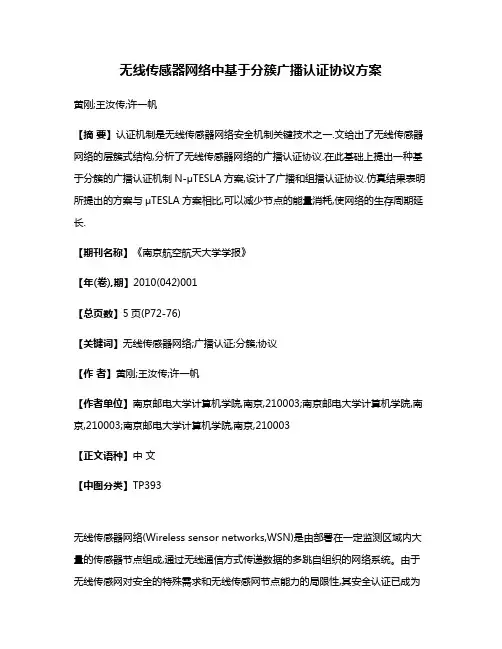
无线传感器网络中基于分簇广播认证协议方案黄刚;王汝传;许一帆【摘要】认证机制是无线传感器网络安全机制关键技术之一.文给出了无线传感器网络的层簇式结构,分析了无线传感器网络的广播认证协议.在此基础上提出一种基于分簇的广播认证机制N-μTESLA方案,设计了广播和组播认证协议.仿真结果表明所提出的方案与μTESLA方案相比,可以减少节点的能量消耗,使网络的生存周期延长.【期刊名称】《南京航空航天大学学报》【年(卷),期】2010(042)001【总页数】5页(P72-76)【关键词】无线传感器网络;广播认证;分簇;协议【作者】黄刚;王汝传;许一帆【作者单位】南京邮电大学计算机学院,南京,210003;南京邮电大学计算机学院,南京,210003;南京邮电大学计算机学院,南京,210003【正文语种】中文【中图分类】TP393无线传感器网络(Wireless sensor networks,WSN)是由部署在一定监测区域内大量的传感器节点组成,通过无线通信方式传递数据的多跳自组织的网络系统。
由于无线传感网对安全的特殊需求和无线传感网节点能力的局限性,其安全认证已成为当前研究的热点和难点。
在 WSN的安全机制中,无线传感网节点间的控制信息安全认证直接关联到部分节点甚至全网节点的工作内容和工作效能。
传统的广播认证协议依赖于非对称的数字签名,不适用于无线传感网。
目前无线传感网控制信息认证采用的是基于广播数据源认证机制的μTESLA协议。
μTESLA协议单一的密钥链导致基站保存过长的密钥链,有时需要多次重构密钥链,这给网络带来了负担。
本文对现有的广播认证方案进行分析,提出一种基于分簇的广播认证机制N-μTESLA,节省了密钥的使用量,延长了网络的生存期,扩展性更好。
1 无线传感器网络的层簇式结构无线传感器的网络结构主要分为分布式、层簇式两大类[1]。
当无线网络规模较大的时候,可以采用聚类分层的管理模式即层簇式的体系结构。
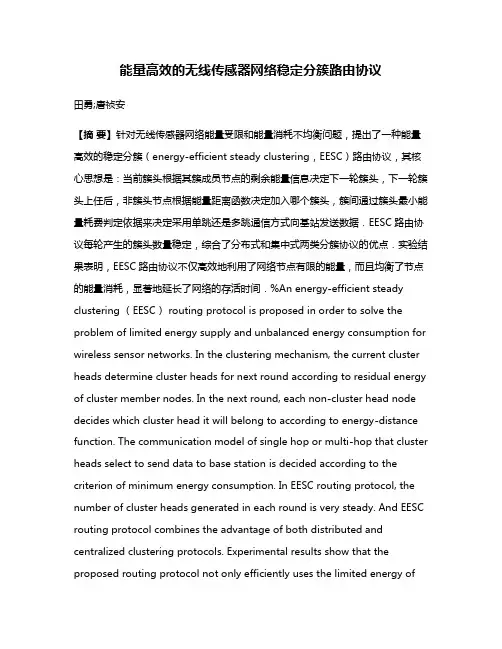
能量高效的无线传感器网络稳定分簇路由协议田勇;唐祯安【摘要】针对无线传感器网络能量受限和能量消耗不均衡问题,提出了一种能量高效的稳定分簇(energy-efficient steady clustering,EESC)路由协议,其核心思想是:当前簇头根据其簇成员节点的剩余能量信息决定下一轮簇头,下一轮簇头上任后,非簇头节点根据能量距离函数决定加入哪个簇头,簇间通过簇头最小能量耗费判定依据来决定采用单跳还是多跳通信方式向基站发送数据.EESC路由协议每轮产生的簇头数量稳定,综合了分布式和集中式两类分簇协议的优点.实验结果表明,EESC路由协议不仅高效地利用了网络节点有限的能量,而且均衡了节点的能量消耗,显著地延长了网络的存活时间.%An energy-efficient steady clustering (EESC) routing protocol is proposed in order to solve the problem of limited energy supply and unbalanced energy consumption for wireless sensor networks. In the clustering mechanism, the current cluster heads determine cluster heads for next round according to residual energy of cluster member nodes. In the next round, each non-cluster head node decides which cluster head it will belong to according to energy-distance function. The communication model of single hop or multi-hop that cluster heads select to send data to base station is decided according to the criterion of minimum energy consumption. In EESC routing protocol, the number of cluster heads generated in each round is very steady. And EESC routing protocol combines the advantage of both distributed and centralized clustering protocols. Experimental results show that the proposed routing protocol not only efficiently uses the limited energy ofnetwork nodes, but also balances the energy consumption of all nodes, and significantly prolones the network lifetirne【期刊名称】《大连理工大学学报》【年(卷),期】2012(052)005【总页数】6页(P755-760)【关键词】无线传感器网络;能量高效;稳定分簇;能量距离函数【作者】田勇;唐祯安【作者单位】大连理工大学电子科学与技术学院,辽宁大连116024 大连东软信息学院嵌入式系统工程系,辽宁大连116024;大连理工大学电子科学与技术学院,辽宁大连116024【正文语种】中文【中图分类】TP3930 引言分簇路由协议是目前无线传感器网络(wireless sensor network,WSN)研究的热点之一,这类协议首先根据某种规则把WSN节点集划分为多个子集,每个子集成为一个簇,具有一个簇头[1].分簇路由协议中如何选取簇头是最关键问题之一,根据簇头选取方式的不同,可以把分簇路由协议分为分布式和集中式两种[2].分布式路由协议包括两类:一类是节点根据某个阈值决定是否当选为簇头,如LEACH (low-energy adaptive clustering hierarchy)协议[3]就是这类分布式协议,它是由节点根据随机数自主决定是否当选为簇头,每轮产生的簇头没有确定的数量和位置;另一类是通过节点之间的信息交互产生簇头,如 HEED(hybrid energy-efficient distributed clustering)协议[4]和 HEED-M 协议[5].HEED协议将节点最大剩余能量和平均最小可达能量作为选择簇头的参数,以便簇内通信代价达到最小,但是此协议为了达到簇内通信代价最小的目的可能多次进行消息迭代,使得通信开销显著增加.HEED-M协议与HEED协议的唯一区别就是HEED协议使用单跳通信的方式,而HEED-M协议使用多跳通信的方式.集中式路由协议是指由基站基于整个网络信息进行簇拓扑结构的划分,被建模为带有特定限制的图形划分问题,现已证明是NP问题[6].文献[7]提出了一种集中式路由协议LEACH-C(LEACH-centralized).这类协议的主要缺点是每个节点必须向基站传送地理位置和剩余能量信息,增加了额外的能量开销.近年来,随着 WSN路由协议研究的不断深入,又出现了大量的分簇协议.文献[8]提出了一种按照网络生命周期最大化原则计算最优传感器节点部署圆环数的方法,并且设计了EBDG(energy-balanced data gathering)协议.Kaur等[9]考虑传感器节点的覆盖范围是一个任意形状的区域,设计了一种带有多种尺寸的固定形状区域的网络.文献[10]研究了线性数据采集传感器网络的均衡能量消耗问题.文献[11]提出了一种新的非均匀分簇路由协议EEUC,该协议利用非均匀的成簇半径,使得靠近基站的簇成员节点数目相对减少.文献[12]提出了EBCA协议,将簇内剩余能量最多的节点作为下一轮簇头节点.本文针对WSN能量受限和能量消耗不均衡问题,提出一种能量高效的稳定分簇(EESC)路由协议.该协议由当前簇头选择剩余能量最大的成员节点为下一轮簇头,下一轮簇头上任后,非簇头节点根据能量距离函数决定加入哪个簇,簇间采用单跳或多跳的通信方式发送数据,以降低能量的消耗.1 网络模型本文研究的WSN由N个随机分布在正方形区域内的传感器节点组成,这些节点周期性地收集周围环境的数据,并按照本文给出的路由协议传输至基站.同时假设网络性质如下:(1)基站位于分布区域外侧,并且它和传感器节点在部署后位置不再发生变化. (2)传感器节点都是具有唯一标识的同构节点,并且能够进行数据融合.(3)传感器节点可以根据接收节点的距离,调整发射功率.(4)传感器节点能够根据接收到的信号强度来计算它到发送节点的近似距离[11]. 本文采用的能量消耗模型由发射电路消耗的能量和功率放大电路消耗的能量两部分组成.功率放大电路的能耗根据发射节点和接收节点之间的距离d有所不同,当d 小于阈值d0时,采用自由空间模型;大于等于阈值d0时,采用多径衰落模型.因此,距离为d的两个节点,发射长度为l的数据所消耗的能量为式中:Eelec表示发射电路的能耗;εfsd2和εmpd4分别为功率放大电路在两种模型中的能耗.接收这些数据所消耗的能量为另外,用Eda表示融合单位比特数据所消耗的能量.2 EESC路由协议EESC路由协议的基本操作过程是:在网络部署完成后,基站用给定的功率向网络广播一个信号,每个传感器节点接收到该信号后,根据信号强度计算出到基站的近似距离.在WSN开始工作之前需要先产生第一轮的簇头,由于第一轮传感器节点的能量都是一样的,直接采用LEACH产生簇头的方法来产生簇头.每个节点选择一个介于0和1的随机数,如果这个数小于阈值p,该节点成为簇头.在第一轮的簇头产生后,协议进入循环阶段:(1)簇头向全网广播其成为簇头的消息,非簇头节点在收到簇头广播的消息后,根据能量距离函数确定其属于的簇,并通知相应的簇头;(2)簇头根据簇成员节点发来的信息,选择其中剩余能量最大的节点为下一轮簇头的接班人;(3)簇成员节点按照TDMA(时分复用)时隙发送数据给簇头,簇头对接收的信息进行数据融合之后,将自己此时的信息广播给所有簇头,然后根据簇头最小能量耗费判定依据来选择通信代价最小的方式将数据融合结果发送给基站;(4)基站通知下一轮簇头的接班人成为簇头的消息,网络进入下一轮循环.2.1 簇的形成每个簇头在新一轮循环开始时,向全网广播簇头消息HEAD_MSG,消息的内容为节点的标识(ID)和当前剩余能量(RE).非簇头节点接收到此消息后,将根据能量距离函数决定加入哪个簇头.首先非簇头节点sj计算它到发送HEAD_MSG消息的簇头(CHi)的距离d(sj,CHi),然后计算能量距离函数f(i,j)为[13]其中i为簇头的ID,j为非簇头节点的ID,REi为簇头的剩余能量.节点sj加入簇头CHi的条件就是使能量距离函数f(i,j)最小.根据能量距离函数的公式可知,非簇头节点向簇头发送信息消耗的能量取决于两者的距离d(sj,CHi),此距离越小能量距离函数f(i,j)越小,非簇头节点向簇头发送消息所消耗的能量就越小;簇头的剩余能量越多,能量距离函数f(i,j)越小,就越有利于平衡全网的能量消耗.当非簇头节点sj决定加入簇头CHi之后,向簇头CHi发送JOIN_MSG消息,消息的内容为节点的ID,以及本轮循环结束后该节点的剩余能量REj,计算如下:其中REj-cur 为节点sj 当前的剩余能量,Ej-sm 为向簇头CHi发送JOIN_MSG消息所消耗的能量,Ej-td为向簇头CHi传输数据所消耗的能量.簇头CHi记录成员节点的ID及其REj信息,然后簇头给每个簇成员节点分配TDMA时隙.2.2 下一轮簇头的产生在簇的形成阶段,簇头CHi记录了其所有成员节点的剩余能量REj信息.为了平衡全网的能量,簇头必须由能量较高的节点来担任,所以簇头可以从成员节点中选择剩余能量REj最大的节点担任下一轮簇头的接班人.2.3 簇间单跳和多跳混合路由协议在所有节点得到其TDMA时隙后,它们按照所分配的TDMA时隙把收集的数据传送给簇头.簇头先对簇成员节点发来的数据以及下一轮的簇头信息进行融合处理,然后将数据以单跳或多跳的通信方式传输至基站.首先采用文献[11]的思想,引入一个阈值TD_MAX.若簇头到基站的距离小于TD _MAX,则它直接将数据传送给基站;否则使用多跳路由的方式与基站进行通信.在选择单跳或者多跳传输之前,每个簇头向全网广播NODE_MSG消息,内容包括其节点标识、它当前的剩余能量和它到基站的距离.下面介绍使用多跳路由方式时,簇头选择中继节点的策略.本文选择比簇头CHi更接近基站的区域中的簇头作为路由候选节点,并且建立相应的集合,簇头CHi的路由候选节点集合定义如下:其中CHk表示路由候选节点,d(CHk,BS)表示路由候选节点CHk和基站BS之间的距离,d(CHi,BS)表示簇头CHi和基站BS之间的距离.簇头CHi将从此集合中选择一个节点CHk作为数据转发中继节点,选择的策略分析如下:假设CHk将数据直接传输至基站,则为了传输长度为l的数据至基站,CHi和CHk消耗的总能量为簇头CHi直接与基站通信消耗的能量为如果簇头CHi的路由候选节点集合RCCHi中仅存在一个候选节点CHk,使得E2hop小于E1hop,则簇头CHi将选择CHk作为其中继节点;如果存在多个候选节点使得E2hop小于E1hop,则簇头CHi将选择剩余能量最大的候选节点作为其中继节点;否则簇头CHi将直接与基站进行通信.3 EESC路由协议分析EESC路由协议利用集中式路由协议的思想解决了分布式路由协议簇头数目不确定和簇头剩余能量难以判断的问题;同时又利用分布式路由协议的思想克服了集中式路由协议必须在基站和节点之间传输信息而耗费额外能量的缺点.下面给出了整个协议的伪码:在此协议中,簇头向全网广播HEAD_MSG消息和NODE_MSG消息时,广播半径设为此簇头到网络覆盖范围的4个顶点的最大值;而发送JOIN_MSG消息时,发送半径为实际到目标节点的距离.该协议是消息驱动的,因此需要分析消息复杂度.性质1 在所选网络中,EESC路由协议的消息复杂度为O(N).证明每一轮开始时,有N×p个簇头共广播N×p条HEAD_MSG消息;而N×(1-p)个非簇头节点共广播N×(1-p)条JOIN_MSG消息;簇头向全网广播剩余能量等信息的NODE_MSG消息共N×p条.因此总的消息开销为即消息复杂度为O(N).性质1说明EESC路由协议的消息复杂度较小,能量效率较高.文献[11]提出的EEUC协议和文献[14]提出的DEEUC协议的消息复杂度也为O(N),并且都低于HEED协议的消息开销.与文献[11,14]协议相比,EESC协议的消息开销更低,因此能量效率更高.4 实验结果及分析为了验证协议的有效性,利用MATLAB对协议进行了仿真测试,实验所用参数如表1所示.表1 实验参数Tab.1 Simulation parameters参数取值网络覆盖范围/m (0,0)~(200,200)基站位置/m (100,250)N 400节点初始能量/J 0.5 Eelec/(nJ·bit-1)50 εfs/(pJ·bit-1·m-2)10 εmp/(pJ·bit-1·m-4)0.001 3 d0/m 87 Eda/(nJ·bit-1) 5数据分组大小/bits 4 000 TD_MAX/m 1404.1 参数p的选择协议中决定簇头数目的参数p的选择是非常重要的,本文用实验方法来确定p的取值.令p从0.01到0.1,观察网络中第一个死亡节点和最后一个死亡节点的轮次(R)随之变化的情况.每个p值实验10次取平均值,实验结果如图1所示.由图可见p=0.04时,网络的第一个死亡节点的轮次最大,当p=0.02时,网路的最后一个死亡节点的轮次最大;而当p=0.04时,从第一个死亡节点到最后一个死亡节点的轮次差值最小,这个轮次差值可以反映网络节点能量消耗的均衡情况,差值越小说明网络的能量消耗越均衡.因此本文取p=0.04,使得网络的存活时间更长,能量消耗均衡程度更好.图1 第一个死亡节点和最后一个死亡节点死亡轮次随参数p的变化Fig.1 The round changes of the first dead node and the final dead node in networks with the parameter p4.2 簇头的能量消耗为了验证本文提出的EESC路由协议能量的高效性和均衡性,将EESC与LEACH、HEED和HEED-M三种分簇路由协议进行比较.由于分簇路由协议中簇头承担了接收成员数据、融合数据和将数据发送给基站等多项任务,是WSN中能量消耗的主要部分.图2显示了随机选取10轮,4种协议的簇头在一轮里消耗能量之和(Et)的比较结果.从图中可以看出,EESC路由协议的簇头消耗的能量之和最低而且波动最小,这是因为EESC协议簇头的消息开销较小,并且簇头采用单跳或多跳的通信方式发送数据至基站,显著降低了能量的消耗;波动最小是由于EESC路由协议的簇头数量在没有节点死亡之前固定不变,簇头消耗的能量之和没有明显的波动.LEACH协议的簇头消耗能量最高,波动最大,是因为它采用单跳通信方式,而且构造的簇头数量较多,导致簇头消耗的能量增大;另外LEACH构造簇头的数量不够稳定,导致簇头消耗的能量之和也有较大差别.HEED和HEED-M协议簇头消耗的能量和波动性处于EESC和LEACH协议之间,而HEED-M协议簇头消耗的能量又低于HEED协议,原因在于HEED-M采用了多跳通信的方式,降低了能量消耗.图2 4种协议的簇头消耗能量之和Fig.2 The sum of energy dissipated by cluster heads in four protocols4.3 网络的生命周期网络生命周期的长短是衡量WSN路由协议优劣的首要设计目标.图3显示了EESC、LEACH、HEED和HEED-M四种协议存活节点数目(Nlife)随轮次变化的情况.存活节点数目可以反映网络能量的使用效率,存活节点越多说明网络的能量使用效率越高.从图中可以看出,由于LEACH协议通过等概率地随机循环选择簇头,将整个网络的能量负载平均分配到每个传感器节点,使得第一个死亡节点出现在大约260轮,而最后一个死亡节点出现在大约600轮.但是,LEACH协议没有考虑节点的剩余能量,并且每轮产生的簇头没有确定的数量,使得网络的生命周期和能量消耗的均衡性并不理想.HEED协议在选择簇头时考虑了节点的剩余能量,并以主从关系引入了多个约束条件作用于簇头的选择过程,同时也考虑了分簇后簇内的通信开销问题,因此第一个死亡节点出现在大约330轮,而最后一个死亡节点出现在大约700轮.与LEACH协议相比,延长了网络生命周期.然而,无论是LEACH协议还是HEED协议,节点都是采用单跳的方式与基站进行通信.HEED-M协议在HEED协议的基础上,将节点与基站的通信方式由单跳改为了多跳,取得了较好的效果.与以上3种协议相比,本文提出的EESC路由协议不仅选择簇内能量最大的节点作为下一轮的簇头,而且在建簇时利用能量距离函数来优化簇内的通信开销,在传输数据时采用单跳和多跳相结合的方式与基站进行通信,因此在大约760轮时才出现第一个死亡节点,而此时其他3种协议的节点已经全部死亡,并且最后一个与第一个死亡节点的差值也远小于其他3种协议,这说明EESC路由协议不仅高效地利用了网络的能量,延长了网络的生命周期,而且网络的能量消耗更加均衡. 图3 4种协议的网络生命周期比较Fig.3 The network lifetime comparison of four protocols5 结语本文提出了一种能量高效的WSN稳定分簇路由协议,该协议利用建簇过程传输节点剩余能量信息,簇头根据簇成员节点的剩余能量来选取下一轮的簇头.这样,不仅使每次产生的簇头能量最大,数目稳定,而且不需要在节点和基站之间传输剩余能量等信息,因此具有分布式和集中式分簇路由协议的共同优点.实验证明了EESC 路由协议能量利用的高效性和能量消耗的均衡性.【相关文献】[1] 李建中,高宏.无线传感器网络的研究进展[J].计算机研究与发展,2008,45(1):1-15.LI Jian-zhong, GAO Hong. Survey on sensor network research[J].Journal of Computer Research and Development,2008,45(1):1-15.(in Chinese)[2] 沈波,张世永,钟亦平.无线传感器网络分簇路由协议[J].软件学报,2006,17(7):1588-1600 SHEN Bo,ZHANG Shi-yong,ZHONG Yi-ping.Cluster-based routing protocolsfor wireless sensor networks[J].Journal of Software,2006,17(7):1588-1600.(in Chinese)[3] Heinzelman W,Chandrakasan A,Balakrishnan H.Energy-efficient communication protocol for wireless microsensor networks [C]// Proceedings of the Hawaii International Conference on System Sciences.Los Alamitos:IEEE,2000:1-10.[4] Younis O,Fahmy S.HEED:a hybrid,energyefficient,distributed clustering approach for ad hoc sensor networks [J].IEEE Transactions on Mobile Computing,2004,3(4):366-379.[5] Younis O,Fahmy S.An experimental study of routing and data aggregation in sensor networks[C]//2nd IEEE International Conference on Mobile Ad-hoc and Sensor Systems,MASS 2005.Piscataway:Institute of Electrical and Electronics Engineers Computer Society,2005:50-57.[6] Rhazi A E,Pierre S.A tabu search algorithm for cluster building in wireless sensor networks [J].IEEE Transactions on Mobile Computing,2009,8(4):433-444.[7] Heinzelman W,Chandrakasan A,Balakrishnan H.An application-specific protocol architecture for wireless microsensor networks [J]. IEEE Transactions on Wireless Communication, 2002,1(4):660-670.[8] ZHANG Hai-bo,SHEN Hong.Balancing energy consumption to maximize network lifetime in datagathering sensor networks[J].IEEE Transactions on Parallel and Distributed Systems,2009,20(10):1526-1539.[9] Kaur T,Baek J.A strategic deployment and clusterheader selection for wireless sensor networks [J].IEEE Transactions on Consumer Electronics,2009,55(4):1890-1897. [10] ZHANG Hai-bo,SHEN Hong, TAN Ya-suo.Optimal energy balanced data gathering in wireless sensor networks [C] // Proceedings -21st International Parallel and Distributed Processing Symposium,IPDPS 2007.Piscataway:Institute of Electrical and Electronics Engineers Computer Society,2007.[11] 李成法,陈贵海,叶懋,等.一种基于非均匀分簇的无线传感器网络路由协议[J].计算机学报,2007,30(1):27-36 LI Cheng-fa,CHEN Gui-hai,YE Mao,et al.An uneven cluster-based routing protocol for wireless sensor networks[J].Chinese Journal of Computers,2007,30(1):27-36.(in Chinese)[12] 杜玉红,张晓敏,蔡成闻.无线传感器网络能量均衡自适应分簇算法[J].传感技术学报,2007,20(7):1616-1619.DU Yu-hong,ZHANG Xiao-min,CAI Cheng-wen.Energy-balanced adaptive clustering algorithm in wireless sensor networks [J].Chinese Journal of Sensors and Actuators,2007,20(7):1616-1619.(in Chinese)[13] 洪利,杨淑玲.一种全局能量均衡的路由协议[J].计算机工程与应用,2010,46(2):86-89.HONG Li, YANG Shu-ling. Overall energybalanced routing protocol[J].Computer Engineering and Applications,2010,46(2):86-89.(in Chinese)[14] 尚凤军,Abolhasan M,Wysocki T.无线传感器网络的分布式能量有效非均匀成簇算法[J].通信学报,2009,30(10):34-43.SHANG Feng-jun,Abolhasan M, WysockiT.Distributed energy efficient unequal clustering algorithm for wireless sensor networks[J].Journal on Communications,2009,30(10):34-43. (in Chinese)。
异构无线传感器网络中一种可恢复数据的安全聚集算法石鲁生;朱慧博;陈林【摘要】现有无线传感器网络的安全聚集算法能耗开销大,聚集类型单一,提出一种针对异构无线传感器网络的可恢复数据的安全聚集算法.算法使用基于椭圆曲线的同态加密技术实现数据隐私保护,利用高效的签名聚集方案为数据完整性和真实性的验证提供可靠保障.算法独特的数据恢复功能,使聚集节点可在得到聚集结果的同时恢复聚集前的原始数据,方便后续操作,也丰富了聚集类型.算法充分利用异构无线传感器网络中的节点差异,将大量计算工作转移至高资源节点,提高了执行效率.仿真实验和对比分析表明,算法安全性好、效率高,虽然单次聚集过程的通信量稍大,但数据恢复节省了后续工作的开销,整体能耗实际有所降低.【期刊名称】《电信科学》【年(卷),期】2013(029)011【总页数】7页(P23-28,37)【关键词】无线传感器网络;数据恢复;数据聚集;隐私保护;异构【作者】石鲁生;朱慧博;陈林【作者单位】宿迁学院计算机科学系宿迁223800;南京航空航天大学计算机科学与技术学院南京210016;宿迁学院计算机科学系宿迁223800;宿迁学院计算机科学系宿迁223800【正文语种】中文1 引言近年来,无线传感器网络(wireless sensor network,WSN)越来越受到人们的关注。
无线传感器网络由微型、低成本、低功耗的微传感器组成,这些传感器可以通过无线通信协同工作,进行数据监测和处理。
目前,无线传感器网络的应用领域已快速扩展至军事、救灾、环境、医疗、家居等众多领域。
在很多应用场景下,不同感知能力、计算能力、通信能力以及不同能量储备的传感器常需要相互配合开展工作,这种由不同类型传感器组成的网络称为异构无线传感器网络(heterogeneous wireless sensor network)[1]。
相对于相同类型传感器组成的同构无线传感器网络(homogeneous wireless sensor network),异构无线传感器网络能满足更多的实际需求[2]。
SEP:AStableElectionProtocolforclusteredheterogeneouswirelesssensornetworks∗
GeorgiosSmaragdakisIbrahimMattaAzerBestavrosComputerScienceDepartmentBostonUniversityBoston,MA02215,USA
{gsmaragd,matta,best}@cs.bu.eduTechnicalReportBUCS-TR-2004-022
ABSTRACTWestudytheimpactofheterogeneityofnodes,intermsoftheiren-ergy,inwirelesssensornetworksthatarehierarchicallyclustered.Inthesenetworkssomeofthenodesbecomeclusterheads,aggre-gatethedataoftheirclustermembersandtransmitittothesink.Weassumethatapercentageofthepopulationofsensornodesisequippedwithadditionalenergyresources—thisisasourceofhet-erogeneitywhichmayresultfromtheinitialsettingorastheoper-ationofthenetworkevolves.Wealsoassumethatthesensorsarerandomly(uniformly)distributedandarenotmobile,thecoordi-natesofthesinkandthedimensionsofthesensorfieldareknown.Weshowthatthebehaviorofsuchsensornetworksbecomesveryunstableoncethefirstnodedies,especiallyinthepresenceofnodeheterogeneity.Classicalclusteringprotocolsassumethatallthenodesareequippedwiththesameamountofenergyandasaresult,theycannottakefulladvantageofthepresenceofnodeheterogene-ity.WeproposeSEP,aheterogeneous-awareprotocoltoprolongthetimeintervalbeforethedeathofthefirstnode(werefertoasstabilityperiod),whichiscrucialformanyapplicationswherethefeedbackfromthesensornetworkmustbereliable.SEPisbasedonweightedelectionprobabilitiesofeachnodetobecomeclusterheadaccordingtotheremainingenergyineachnode.WeshowbysimulationthatSEPalwaysprolongsthestabilityperiodcomparedto(andthattheaveragethroughputisgreaterthan)theoneobtainedusingcurrentclusteringprotocols.WeconcludebystudyingthesensitivityofourSEPprotocoltoheterogeneityparameterscaptur-ingenergyimbalanceinthenetwork.WefoundthatSEPyieldslongerstabilityregionforhighervaluesofextraenergybroughtbymorepowerfulnodes.
1.INTRODUCTIONMotivation:WirelessSensorNetworksarenetworksoftiny,bat-terypoweredsensornodeswithlimitedon-boardprocessing,stor-ageandradiocapabilities[1].Nodessenseandsendtheirreportstowardaprocessingcenterwhichiscalled“sink.”Designingpro-tocolsandapplicationsforsuchnetworkshastobeenergyawareinordertoprolongthelifetimeofthenetwork,becausethereplace-mentoftheembeddedbatteriesisaverydifficultprocessoncethesenodeshavebeeninstalled.ClassicalapproacheslikeDirectTrans-
∗ThisworkwassupportedinpartbyNSFgrantsANI-0095988,
ANI-9986397,EIA-0202067,andITRANI-0205294.
.
missionandMinimumTransmissionEnergy[9]donotguaranteewellbalanceddistributionoftheenergyloadamongnodesofthesensornetwork.UsingDirectTransmission(DT),sensornodestransmitdirectlytothesink,asaresultnodesthatarefarawayfromthesinkwoulddiefirst[6].Ontheotherhand,usingMini-mumTransmissionEnergy(MTE),dataisroutedoverminimum-costroutes,wherecostreflectsthetransmissionpowerexpended.UnderMTE,nodesthatarenearthesinkactasrelayswithhigherprobabilitythannodesthatarefarfromthesink.Theseformernodestendtodiefast.UnderbothDTandMTE,apartofthefieldwillnotbemonitoredforasignificantpartofthelifetimeofthenetwork,andasaresultthesensingprocessofthefieldwillbebi-ased.Asolutionproposedin[7],calledLEACH,guaranteesthattheenergyloadiswelldistributedbydynamicallycreatedclusters,usingclusterheadsdynamicallyelectedaccordingtoaprioriop-timalprobability.Clusterheadsaggregatereportsfromtheirclus-termembersbeforeforwardingthemtothesink.Byrotatingthecluster-headroleuniformlyamongallnodes,eachnodetendstoexpendthesameenergyovertime.MostoftheanalyticalresultsforLEACH-typeschemesareob-tainedassumingthatthenodesofthesensornetworkareequippedwiththesameamountofenergy—thisisthecaseofhomogeneoussensornetworks.Inthispaperwestudytheimpactofheterogene-ityintermsofnodeenergy.Weassumethatapercentageofthenodepopulationisequippedwithmoreenergythantherestofthenodesinthesamenetwork—thisisthecaseofheterogeneoussen-sornetworks.Wearemotivatedbythefactthattherearealotofapplicationsthatwouldhighlybenefitfromunderstandingtheim-pactofsuchheterogeneity.Oneoftheseapplicationscouldbethere-energizationofsensornetworks.Asthelifetimeofsensornet-worksislimitedthereisaneedtore-energizethesensornetworkbyaddingmorenodes.Thesenodeswillbeequippedwithmoreenergythanthenodesthatarealreadyinuse,whichcreateshet-erogeneityintermsofnodeenergy.Notethatduetopractical/costconstraintsitisnotalwayspossibletosatisfytheconstraintsforop-timaldistributionbetweendifferenttypesofnodesasproposedin[8].Therearealsoapplicationswherethespatialdensityofsensorsisaconstraint.Assumingthatwiththecurrenttechnologythecostofasensoristensoftimesgreaterthanthecostofembeddedbat-teries,itwillbevaluabletoexaminewhetherthelifetimeofthenetworkcouldbeincreasedbysimplydistributingextraenergytosomeexistingnodeswithoutintroducingnewnodes.1